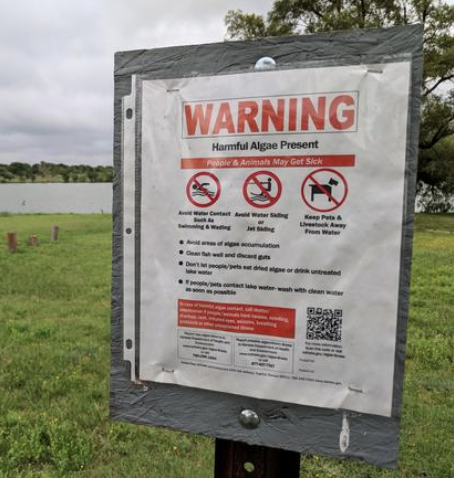By BRIAN GRIMMETT
Kansas News Service
WICHITA — Toxic blue-green algal blooms have been causing major problems on Kansas’ lakes since about 2010.

BRIAN GRIMMETT / KANSAS NEWS SERVICE
Because the pond scum can make people sick, the lakes became out of bounds for swimmers and the like.
The algae, also known as cyanobacteria, can cause rashes, stomachaches, and diarrhea if touched or swallowed. Blooms have even killed small animals unlucky enough to drink the toxic water.
Typically, it’s mostly a problem for recreational use of the lakes.
But many of those lakes also feed into municipal water systems. The blooms have recently begun fouling water treatment plants. Their operators, in turn, have had to change the way they process and treat it.
Toxic algae has bloomed on Keith Sebelius Lake in Norton County, Kansas, since 2014. While a nuisance, it hadn’t really impacted the city of Norton’s water — until last year when the bloom drifted toward, and into, the plant’s intake pipes.
To protect the drinking water supply, the whole plant had to be shut down. Most of the tanks had to be drained and cleaned.
“Oh, you can’t print that,” plant supervisor Jamie Amlong joked when asked what his first thoughts were when he found the bloom had made it into the plant.
He said the blooms have made his job horribly stressful. Any time there’s a bloom, he’s constantly worried about the potential for toxins to make it through the plant and into the town’s faucets and sinks.
This year, water quality tests sent to the Kansas Department of Health and Environment detected very low levels of toxins in water coming out of the treatment plant.
Four other municipal water plants — Hillsboro, Marion, Carbondale and Yates Center — have also discovered toxins in their finished water after blue-green algae blooms.
The levels detected are so small that they aren’t even close to exceeding the safe level determined by the Environmental Protection Agency. Still, the news has caused additional stress and costs for several small municipal water agencies.
It’s the first time KDHE has ever detected the toxins in treated water. But the detection of it’s likely because tests are getting better and because KDHE is helping small utilities test more frequently.
Starting this year, KDHE offered to highly subsidize water quality tests aimed at looking for toxins created by cyanobacteria. The tests, which usually cost $100 to $130 each, will now cost program participants $25 each.
Of the 72 systems that get their water from rivers and lakes in the state, 23 signed up for the program.
Robert Gavin, KDHE Public Water Supply section professional geologist, said the program allows local water systems to prevent tainted water rather than try to reverse a problem.
Previously, state park officials would detect a bloom on a lake. Then they’d notify the state public water division, which would scramble to get tests out to those locations.
But now, bottles for raw water samples are sent out weekly in the mail. If there’s ever a positive test result, more bottles are sent to test the treated water.
“After a couple of years, this will probably be old hat. They’ll kind of just know what to do,” Gavin said. “But they’re all kind of learning right now.”
There is a safe and effective method to remove those toxins.
Officials at KDHE recommend the plants add activated carbon to their water treatment process. The activated carbon is able to latch on to the algae, making it heavier. It then falls to the bottom of settling ponds allowing the clean water to move on through the rest of the process.
It’s a relatively simple addition, but something that most smaller plants didn’t do until now.
It also costs more money — a relatively modest expense that smaller water systems struggle with.
“Any time there’s an algae bloom out at the lake there’s potential for that to get into the plant and through town,” said Amlong, the Norton County water plant supervisor. “We’re on pins and needles from the beginning of the bloom until two or three weeks after the bloom.”
Brian Grimmett reports on the environment, energy and natural resources for the Kansas News Service. You can follow him on Twitter @briangrimmett or email him at grimmett (at) kmuw (dot) org.
